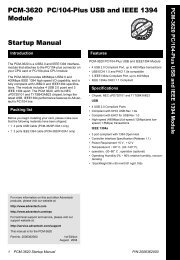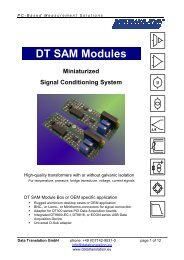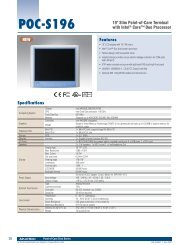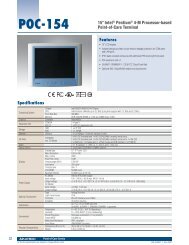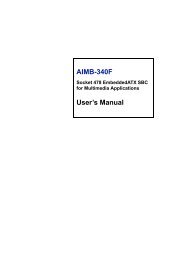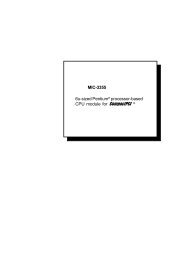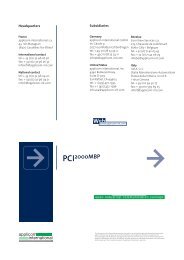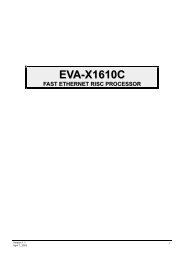You also want an ePaper? Increase the reach of your titles
YUMPU automatically turns print PDFs into web optimized ePapers that Google loves.
<strong>PCM</strong>-3643 PC/104 8-Port RS-232 Module<br />
<strong>Startup</strong> <strong>Man</strong>ual<br />
Introduction<br />
Advantech introduced its new PC/104-compatible<br />
communication module with eight individually<br />
configurable RS-232 ports, <strong>PCM</strong>-3643. Targeting<br />
embedded system customers with a need for highspeed<br />
and shared IRQ ports, high -performance <strong>PCM</strong>-<br />
3643 is especially suitable for multitasking environments.<br />
The <strong>PCM</strong>-3643 provides versatile function<br />
settings to meet users needs. These function settings<br />
include Standard/Enhance setting, Independent/Shared<br />
IRQ setting and Speed setting. Standard/Enhance<br />
setting can help users to flexibly use base address.<br />
Especially in Enhance setting, different base<br />
addresses can be set according to the application. In<br />
Shared IRQ setting, all eight interrupt ports can be<br />
specified to one. This solves IRQ insufficiency<br />
problems within the embedded system. In Speed<br />
setting, the <strong>PCM</strong>-3643 allows transmission rate up to<br />
921.6 kbps. It improves the performance of the system.<br />
Packing List<br />
Before you begin installing your card, please make sure<br />
that the following materials have been shipped:<br />
• 1 <strong>PCM</strong>-3643 PC/104 Multi COM Port module<br />
• 1 Start-up manual<br />
• 1 CD-ROM or Disks for utility, drivers, and manual (in<br />
PDF format)<br />
• COM Port Cable= pn: 1700400220 (1 COM Port cable<br />
for <strong>PCM</strong>-3643-04A1, and 2 COM Port cables for<br />
<strong>PCM</strong>-3643-08A1)<br />
If any of these items are missing or damaged, contact<br />
your distributor or sales representative immediately.<br />
For more information on this and other Advantech<br />
products, please visit our website at:<br />
http://www.advantech.com<br />
http://www.advantech.com/epc<br />
For technical support and service, please visit our support<br />
website at:<br />
http://www.advantech.com/support<br />
This manual is for the <strong>PCM</strong>-3643 Rev.A1<br />
Part No. 2006364312 3rd Edition<br />
Printed in Taiwan October 2002<br />
Features<br />
<strong>PCM</strong>-3643 PC/104 8-port RS-232 Module<br />
• Chipset: 16C550 (4 sets of 16550) standard<br />
serial port chipset<br />
• Channel: 4/8 port RS-232 support<br />
• IRQ: 3, 4, 5, 7, 9, 10, 11, 12<br />
• Baud rate: 50 ~ 921.6 kbps<br />
• Charter length: 5, 6, 7 or 8 bits<br />
• Stop bits: 1, 1.5, 2<br />
• Parity: none, even, odd<br />
• Data signals: TxD, RxD, RTS, CTS, DTR, DSR,<br />
DCD, RI, GND<br />
Mechanical and Environment<br />
• Power consumption: +5 V @ 400 mA (typical)<br />
• Power requirement: +5 V@ ± 5% tolerance on<br />
power supply<br />
• Size/Weight: 96 mm x 90 mm (3.8" x 3.5"),<br />
.084 kg (.185lb)<br />
• Operating Temperature.: 0 ~ 60° C (32 ~ 140°F)<br />
• Storage Temperature: -40 ~ 85° C (-40 ~ 185°F)<br />
• Operating humidity: 0 ~ 90% Rel Humd.,<br />
noncondensing<br />
Installation<br />
Connectors and jumpers<br />
CN1: 1st 4 COM port connector<br />
CN2: 2nd 4 COM port connector<br />
CON1: PC/104 connector<br />
JP1: (Reserve)<br />
JP2,4,6,8: IRQ setting for 1st 4 COM port<br />
JP3,5,7,9: IRQ setting for 2nd 4 COM port<br />
S1: Interrupt vector address setting<br />
S2: COM port base I/O address setting<br />
<strong>PCM</strong>-3643 <strong>Startup</strong> <strong>Man</strong>ual 1<br />
<strong>PCM</strong>-3643 PC/104 8-Port RS-232 Module
Mechanical Drawing<br />
CN2 (COM 5-<br />
COM8)<br />
2nd 16C554<br />
•<br />
JP2 •<br />
JP4 •<br />
JP6 •<br />
JP8 •<br />
2 <strong>PCM</strong>-3643 <strong>Startup</strong> <strong>Man</strong>ual<br />
•<br />
•<br />
JP1<br />
•<br />
•<br />
CON1<br />
•<br />
•<br />
•<br />
JP10<br />
•<br />
•<br />
S2<br />
•<br />
S1<br />
•<br />
1st 16C554<br />
CN1 (COM1~COM4)<br />
JP3<br />
JP3<br />
JP3<br />
JP3
Jumper Setting<br />
(1) S1: Interrupt vector address setting/ I/O addressing mode/ IRQ sharing mode<br />
S1 (switch 1 ~ switch 5): Interrupt vector address setting<br />
ON<br />
*Default setting<br />
S1<br />
8<br />
7<br />
6<br />
5<br />
4<br />
3<br />
2<br />
1<br />
OFF<br />
Default Setting:<br />
Interrupt vector address= 280H<br />
I/O Addressing mode= Enhance mode<br />
IRQ sharing mode= 4 COM share one IRQ<br />
Switch5Switch4 Switch3 Switch2 Switch<br />
1<br />
Interrupt<br />
Register<br />
ONON ON ON ON 200H<br />
ONON ON ON OFF 210H<br />
ONON ON OFF ON 220H<br />
ONON ON OFF OFF 230H<br />
ONON OFF ON ON 240H<br />
ONON OFF ON OFF 250H<br />
ONON OFF OFF ON 260H<br />
ONON OFF OFF OFF 270H<br />
ONOFF ON ON O N 280H*<br />
ONOFF ON ON OFF 290H<br />
ONOFF ON OFF ON 2A0H<br />
ONOFF ON OFF OFF 2B0H<br />
ONOFF OFF ON ON 2C0H<br />
ONOFF OFF ON OFF 2D0H<br />
ONOFF OFF OFF ON 2E0H<br />
ONOFF OFF OFF OFF 2F0H<br />
OFFON ON ON ON 300H<br />
OFFON ON ON OFF 310H<br />
OFFON ON OFF ON 320H<br />
OFFON ON OFF OFF 330H<br />
OFFON OFF ON ON 340H<br />
OFFON OFF ON OFF 350H<br />
<strong>PCM</strong>-3643 <strong>Startup</strong> <strong>Man</strong>ual 3
S1 (switch 6): I/O addressing mode<br />
*Default setting<br />
S1 (switch 7, switch 8): IRQ sharing mode select<br />
Switch8Switch7 Mode<br />
*Default setting<br />
ONON Independe<br />
nt<br />
IRQ<br />
Mode<br />
ONOFF COM<br />
1 ~ COM<br />
8 share<br />
1 IRQ<br />
assigned<br />
by<br />
JP2<br />
O FF*<br />
ON*<br />
OFFOFF 4 <strong>PCM</strong>-3643 <strong>Startup</strong> <strong>Man</strong>ual<br />
OFFON OFF OFF ON 360H<br />
OFFON OFF OFF OFF 370H<br />
OFFOFF ON ON ON 380H<br />
OFFOFF ON ON OFF 390H<br />
OFFOFF ON OFF ON 3A0H<br />
OFFOFF ON OFF OFF 3B0H<br />
OFFOFF OFF ON ON 3C0H<br />
OFFOFF OFF ON OFF 3D0H<br />
OFFOFF OFF OFF ON 3E0H<br />
OFFOFF OFF OFF OFF 3F0H<br />
O N Standard<br />
mode<br />
( 3F8,<br />
2F8,<br />
3E8,<br />
2E8,<br />
240,<br />
248,<br />
250,<br />
258<br />
)<br />
O FF*<br />
Enhance<br />
mode<br />
( use<br />
S2<br />
select<br />
base<br />
address)<br />
COM<br />
1 ~ COM<br />
4 share<br />
1 IRQ<br />
assigned<br />
by<br />
JP2<br />
COM<br />
5 ~ COM<br />
8 share<br />
1 IRQ<br />
assigned<br />
by<br />
JP3<br />
COM<br />
1 and<br />
COM<br />
2 share<br />
1 IRQ<br />
assigned<br />
by<br />
JP2<br />
COM<br />
3 and<br />
COM<br />
4 share<br />
1 IRQ<br />
assigned<br />
by<br />
JP6<br />
COM<br />
5 and<br />
COM<br />
6 share<br />
1 IRQ<br />
assigned<br />
by<br />
JP3<br />
COM<br />
7 and<br />
COM<br />
8 share<br />
1 IRQ<br />
assigned<br />
by<br />
JP7
(2) S2: Base I/O address setting / Speed selection / Operation system select<br />
8<br />
7<br />
6<br />
5<br />
Default setting:<br />
4<br />
3<br />
2<br />
I/O Address=240H<br />
Speed=normal<br />
Operating system=98/NT<br />
ON<br />
1 OFF<br />
S2<br />
S2 (switch 1 ~ switch 6): COM Port base I/O address setting<br />
Switch<br />
1 Switch<br />
2 Switch<br />
3 Switch<br />
4 Switch<br />
5 Switch<br />
6 Base<br />
A3<br />
( Bit1)<br />
A4<br />
( Bit2)<br />
A5<br />
( Bit3)<br />
A6<br />
( Bit4)<br />
A7<br />
( Bit5)<br />
A8<br />
( Bit6)<br />
Address<br />
8h10h 20h 40h 80h 100h<br />
OnOn On On On On 200<br />
- 207h<br />
OffOn On . .<br />
On On On 208<br />
- 20Fh<br />
OnOn On . . .<br />
Off On On 240<br />
- 247h<br />
OnOn On On On Off 300<br />
- 307h<br />
OnOn On Off Off Off 3C0<br />
- 3C7h<br />
*Default Settings<br />
Base address = 200h + 8h (switch 1) + 10h (switch 2) + 20h (switch 3) + 40h (switch 4) + 80h<br />
(switch 5) + 100h (switch 6)<br />
For example: Base address 240h = 200h + 8h (On) +10h (On) + 20h (On) + 40h (Off) + 80h (On) +<br />
100h (On)<br />
COM Port I/O address<br />
S2 (switch 7): Speed selection<br />
*Default setting<br />
S2 (switch 8): Operation system select<br />
*Default setting<br />
COMPortI/ O address<br />
COM1BaseAddress+ 00H<br />
COM2BaseAddress+ 08H<br />
COM3Base+ 10H<br />
COM4Base+ 18H<br />
COM5Base+ 20H<br />
COM6Base+ 28H<br />
COM7Base+ 30H<br />
COM8Base+ 38H<br />
ON* Normal<br />
speed<br />
OFFHighspeed ON* 98/<br />
NT<br />
OFFDOS <strong>PCM</strong>-3643 <strong>Startup</strong> <strong>Man</strong>ual 5
(3) JP2 ~ JP9: IRQ Select<br />
IRQ<br />
3 4 5 7 9 10 11 12<br />
JP2,4,6,8; JP3,5,7,9------IRQ Select<br />
Bit1 - IRQ3<br />
Bit2 - IRQ4<br />
Bit3 - IRQ5<br />
Bit4 - IRQ7<br />
Bit5 - IRQ9<br />
Bit6 - IRQ10<br />
Bit7 - IRQ11<br />
Bit8 - IRQ12<br />
Note: The right jumper is Bit8 and the left is Bit1.<br />
Note: Share mode recommended 4 COM Share 1 IRQ.<br />
The Advantech <strong>PCM</strong>-3643 PC/104 Serial Port Module is<br />
flexible in that it can use multiple configurations of<br />
jumpers JP2 to JP9 to control IRQ sharing. Here are<br />
the choices:<br />
1. Can use 1 COM port with 1 IRQ, so<br />
JP2 controls COM1<br />
JP4 controls COM2<br />
JP6 controls COM3<br />
JP8 controls COM4<br />
JP3 controls COM5<br />
JP5 controls COM6<br />
JP7 controls COM7<br />
JP9 controls COM8<br />
2. Can use 2 COM ports shared on 1 IRQ<br />
JP2 controls COM1 and COM2<br />
JP4-inactive<br />
JP6 COM3 and COM4<br />
JP8-inactive<br />
JP3 COM5 and COM6<br />
JP5-inactive<br />
JP7 COM7 and COM8<br />
JP9-inactive<br />
6 <strong>PCM</strong>-3643 <strong>Startup</strong> <strong>Man</strong>ual<br />
3.Can use 4 COM ports shared on 1 IRQ<br />
(Default setting)<br />
JP2 controls COM1,COM2,COM3,COM4<br />
JP4-inactive<br />
JP6-inactive<br />
JP8-inactive<br />
JP3 controls COM5,COM6,COM7,COM8<br />
JP5-inactive<br />
JP7-inactive<br />
JP9-inactive<br />
4. Can use 8 COM ports shared on 1 IRQ<br />
JP2 controls<br />
COM1,COM2,COM3,COM4,COM5,COM6,COM7,COM8<br />
JP4-inactive<br />
JP6-inactive<br />
JP8-inactive<br />
JP3-inactive<br />
JP5-inactive<br />
JP7-inactive<br />
JP9-inactive<br />
Example: Lets use the default for example. 4 COM<br />
ports (COM1, COM2, COM3, COM4) are controlled by<br />
JP2 (jumped), so, JP4, JP6, JP8 are ignored.<br />
Note: You can't use the same IRQ at the same time.<br />
So, in our example above, since IRQ3 is being used<br />
by COM1, COM2, COM3, COM4 (default setting), you<br />
can't use IRQ3 again by jumping JP3 to use COM5,<br />
COM6, COM7, COM8. You have to use a different<br />
IRQ.<br />
Default setting: 4 COM ports share 1 1 IRQ, JP2 set<br />
to IRQ5, JP3 set to IRQ10<br />
JP2<br />
IRQ 3 4 5 7 9 10 11 12<br />
JP3<br />
IRQ<br />
3 4 5 7 9 10 11 12
CN1: COM 1-4 Assignments<br />
Pin # Assignment<br />
1 NDCDO<br />
2 NDSRO<br />
3 NRXO<br />
4 NRT SO<br />
5 NTXO<br />
6 NCT SO<br />
7 NDTRO<br />
8 RI_O<br />
9 GND<br />
10 GND<br />
11 NDCD1<br />
12 NDSR1<br />
13 NRX1<br />
14 NRT S1<br />
15 NTX1<br />
16 NCT S1<br />
17 NDTR1<br />
18 RI_1<br />
19 GND<br />
20 GND<br />
21 NDCD2<br />
22 NDSR2<br />
23 NRX2<br />
24 NRT S2<br />
25 NTX2<br />
26 NCT S2<br />
27 NDTR2<br />
28 RI_2<br />
29 GND<br />
30 GND<br />
31 NDCD3<br />
32 NDSR3<br />
33 NRX3<br />
34 NRTS3<br />
35 NTX3<br />
36 NCTS3<br />
37 NDTR3<br />
38 RI_3<br />
39 GND<br />
40 GND<br />
CN2: COM 5-8 Assignments<br />
Pin # Assignment<br />
1 NDCD4<br />
2 NDSR4<br />
3 NRX4<br />
4 NRT S4<br />
5 NTX4<br />
6 NCT S4<br />
7 NDTR4<br />
8 RI_4<br />
9 GND<br />
10 GND<br />
11 NDCD5<br />
12 NDSR5<br />
13 NRX5<br />
14 NRT S5<br />
15 NTX5<br />
16 NCT S5<br />
17 NDTR5<br />
18 RI_5<br />
19 GND<br />
20 GND<br />
21 NDCD6<br />
22 NDSR6<br />
23 NRX6<br />
24 NRT S6<br />
25 NTX6<br />
26 NCT S6<br />
27 NDTR6<br />
28 RI_6<br />
29 GND<br />
30 GND<br />
31 NDCD7<br />
32 NDSR7<br />
33 NRX7<br />
34 NRTS7<br />
35 NTX7<br />
36 NCTS7<br />
37 NDTR7<br />
38 RI_7<br />
39 GND<br />
40 GND<br />
<strong>PCM</strong>-3643 <strong>Startup</strong> <strong>Man</strong>ual 7
Windows 98 Driver Installation<br />
1. Run Windows. Launch the Add New Hardware wizard<br />
from Control Panel.<br />
Press the Next button twice to dismiss the first two<br />
pages.<br />
2. You see a dialog listing devices. Select "No, the<br />
device isn't in the list," and press the Next button.<br />
3. If you see a dialog asking your permission to search<br />
for hardware that isn't Plug and Play compatible,<br />
select the choice that reads, "No, I want to select<br />
the hardware from a list," and press the Next button.<br />
4. You'll now see a dialog that asks you to "Select the<br />
type of hardware you want to install." Select the<br />
"Other devices" choice and press the Next button.<br />
5. If you're installing a <strong>PCM</strong>-3643 for the first time,<br />
press the "Have Disk" button. In the ensuing dialog,<br />
enter the directory where the <strong>PCM</strong>-3643 INF file is<br />
located.<br />
6. After selecting the appropriate INF directory, the<br />
device will be listed in the Models list box. Select<br />
one choice and press Next.<br />
7. In the final dialog, press the Finish button. The<br />
wizard will now copy files to perform the installation.<br />
8. Please click the "System" icon in Control Panel and<br />
click Device <strong>Man</strong>ager tab.<br />
Select "Multi-function" adapter and double click the<br />
<strong>PCM</strong>-3643 item.<br />
9. Click Adapter settings page, then please fill in IRQ<br />
and Base Address.<br />
10. Restart system.<br />
8 <strong>PCM</strong>-3643 <strong>Startup</strong> <strong>Man</strong>ual<br />
Standard Mode<br />
4 ports<br />
IRQ 4 ports share 1 IRQ<br />
IOBASE 0x3f8, 0x2f8, 0x3ef, 0x2fe<br />
8 ports<br />
IRQ 8 ports share 2 IRQs<br />
IOBASE 0x3f8, 0x2f8, 0x3ef, 0x2fe, 0x240,<br />
0x248, 0x250, 0x258<br />
Example:<br />
JP2 = IRQ3<br />
JP3 = IRQ4<br />
Switch1 Bit6 = On<br />
Bit7 = On<br />
Bit8 = Off<br />
Note: Please disable onboard COM1, COM2.<br />
Enhanced Mode<br />
4 ports<br />
IRQ 4 ports share 1 IRQ<br />
IOBASE Base, Base+0x8, Base+0x10,<br />
Base+0x18<br />
8 ports<br />
IRQ 8 ports share 2 IRQs<br />
IOBASE Base, Base+0x8, Base+0x10,<br />
Base+0x18, Base+0x20, Base+0x28,<br />
Base+0x30, Base+0x38
Windows NT Port Setup and Testing<br />
Under Win NT, do the manual hardware settings, then<br />
set up the needed ports in BIOS and Windows Control<br />
Panel.<br />
Hardware settings:<br />
SW1: Set SW1 (see page 3)<br />
Example: 11101001 (1:on, 0:off) (bit1...bit8)<br />
Interrupt vector address= 280H<br />
I/O Addressing mode= Enhance mode<br />
IRQ sharing mode= COM1~COM8 share 1 IRQ<br />
assigned by JP2<br />
SW2:Set SW2 (see page 5)<br />
Example:11101111 (1:on, 0:off) (bit1...bit8)<br />
I/O Address= 240H<br />
Speed= Normal<br />
Operation system= 98/NT<br />
JUMPER settings: (see page 2, ff.)<br />
Example setting: JP2-CH1 Bit 3 (IRQ5)<br />
8 COM ports (COM1~COM8) are controlled by JP2<br />
(Jumped), so JP3~JP9 are ignored<br />
BIOS settings:<br />
In BIOS, go to PnP/PCI Configuration=>Resource<br />
controlled by "<strong>Man</strong>ual" => go to "IRQ resource"=> Set<br />
IRQ 5 as "Legacy ISA" Example: IRQ5.<br />
Windows Control Panel settings:<br />
In Control panel, add the COM3~10 Ports. All of them<br />
are set at IRQ 5. Set the base I/O port addresses for<br />
COM 3/4/5/6/7/8/9/10 at 240/248/250/258/260/268/<br />
270/278 respectively.<br />
Testing method:<br />
You can test all COM ports using the COM Terminal<br />
Tool located in Advantech ISA Comm tools.<br />
Step1: Enter the testing program.<br />
Step2: Select the "Settings" function to enter the TTY<br />
Settings and input the data as shown. Then<br />
click the "OK" button. Repeat through COM10.<br />
<strong>PCM</strong>-3643 <strong>Startup</strong> <strong>Man</strong>ual 9
Step3: Select "Action" > "Connect" function to test if<br />
the COM port is set successfully or not.<br />
Step4: If the COM port is set correctly, a cursor should<br />
appear in the TTY screen.<br />
10 <strong>PCM</strong>-3643 <strong>Startup</strong> <strong>Man</strong>ual<br />
If the COM port is not set correctly, you will see<br />
the following error message, in which case,<br />
backtrack and try again.




